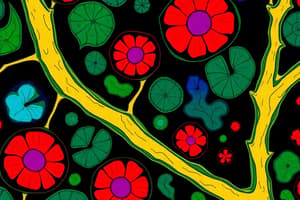Podcast
Questions and Answers
What is the primary function of procambium in plants?
What is the primary function of procambium in plants?
- To enhance photosynthesis in leaves
- To store nutrients for plant growth
- To develop secondary growth tissues
- To develop into primary vascular tissues (correct)
Where is intercalary meristem typically found in monocots?
Where is intercalary meristem typically found in monocots?
- Inside the vascular bundles
- At the base of nodes and leaf blades (correct)
- Throughout the entire plant body
- At the tips of roots and stems
What adaptive advantage does intercalary meristem provide to certain plants?
What adaptive advantage does intercalary meristem provide to certain plants?
- Rapid regrowth of leaves and elongation of stems (correct)
- Improved seed dispersal mechanisms
- Enhanced resistance to diseases
- Increased root depth for water absorption
Which statement is true regarding meristematic tissues?
Which statement is true regarding meristematic tissues?
Which type of plant tissue is primarily responsible for increasing plant height?
Which type of plant tissue is primarily responsible for increasing plant height?
Flashcards
Procambium function
Procambium function
Part of apical meristem, forming primary vascular tissues (xylem and phloem).
Intercalary meristem
Intercalary meristem
Primary meristem promoting plant growth in length (monocot nodes/blades).
Intercalary meristem location
Intercalary meristem location
At the base of monocot nodes and leaf blades.
Intercalary growth benefit
Intercalary growth benefit
Signup and view all the flashcards
Primary meristem
Primary meristem
Signup and view all the flashcards
Study Notes
Plant Tissues
- Plant tissues are categorized as meristematic and permanent.
- Meristematic tissues have the capacity to divide.
- Permanent tissues do not divide.
Meristematic Tissues
- Meristematic tissues are further classified by origin and position.
- Primary meristems are further subdivided into apical, intercalary, and lateral.
Primary Meristems
- Apical Meristems: Located at the tips of roots and shoots, responsible for primary growth (increase in length). Procambium is part of this tissue that develops into xylem and phloem.
- Intercalary Meristems: Located at the base of leaves and internodes in monocots, for example grasses, allows for regrowth after grazing by herbivores or mowing.
- Lateral Meristems: Located on the sides of stems and roots, for example Dicots, responsible for secondary growth (increase in diameter).
Growth in plants
- Primary growth increases stem and root length.
- Secondary growth increases stem and root diameter.
Apical vs Intercalary vs Lateral Meristem
-
Apical Meristem: Located at the tips of roots and shoots. Functional role increasing height by facilitating shoot and root growth.
-
Intercalary Meristem: Located between the tip and base of leaves and stems in monocots (grass family). Contributes to increasing height with growth of internodes.
-
Lateral Meristem: Located on the sides of stems and roots in dicots. Increases thickness, by increasing diameter.
-
Monocots, like grasses, have intercalary meristems that allow leaves to grow back after mowing.
-
Dicots have lateral meristems that produce secondary growth to increase the diameter.
Studying That Suits You
Use AI to generate personalized quizzes and flashcards to suit your learning preferences.




